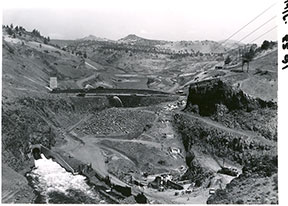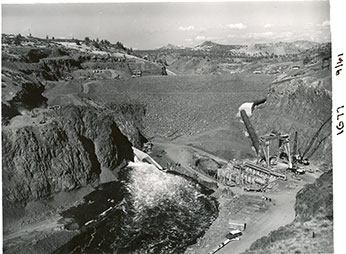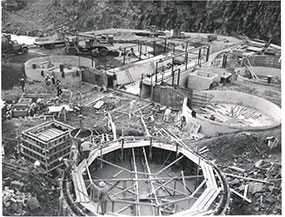The Klamath River and its drainages have long been of interest in terms of fisheries and fishing. Multiple sites along the Klamath River near the current hatchery site have been used as egg collection stations and/or hatcheries dating back over 100 years.
Cottonwood Creek Egg Collection Station 1900 - 1938
The first of the many egg collection stations to appear along the Klamath River, Cottonwood Creek Egg Collection Station was located near the town of Hornbrook in Siskiyou County. A rack and trap was placed into Cottonwood Creek in 1901. Hatchery troughs were also installed for eggs development. Unfortunately the water was too alkaline for proper egg development so fertilized eggs were shipped to Mount Shasta Hatchery. Cottonwood Creek Egg Collection Station continued operations until 1938 despite the trap being washed out by high water multiple times.
Camp Creek 1910-1934 and Bogus Creek 1910 - 1941 Egg Collection Station
Both tributaries to the Klamath River, Camp and Bogus Creek Egg Collection Stations were both built in 1910. Steelhead were trapped, spawned and eggs were shipped to Mount Shasta for distribution to other hatcheries throughout the state. In 1934 low water levels caused Camp Creek Egg Collection Station to close. Soon after, in 1941 Bogus Creek Egg Collection Station also closed, due to wartime personnel shortages.
Klamathon Egg Collection Station 1910 - 1940
Klamathon Egg Collection Station was originally installed by the U.S. Bureau of Fisheries in 1910. Like the other egg collection stations, eggs were sent to Mount Shasta Hatchery for development, and fish were returned to the Klamath River. For the first 5 years, a hatchery was in operation at Klamathon; however, when the State of California took over complete operation in 1915 operations of the hatchery building was discontinued and only eggs were collected.
In 1918 after extensive repair, plans were made to couple the Klamathon Egg Collection Station with the new hatchery being built on Fall Creek. Eggs continued to be collected at Klamathon and sent to Fall Creek until 1940, when the station ceased egg take and was operated as a salmon counting station only.
Fall Creek Hatchery 1919 - 1948
Built by the California Oregon Power Company as compensation for lost of spawning grounds due to the construction of Copco No.1 Dam, Fall Creek Hatchery started with a 116 trough hatchery building, three ponds and two employee houses. Salmon eggs were received from Klamathon Egg Collection Station, and steelhead eggs were brought from Bogus and Camp Creek Egg Collection Stations. In 1937 the numbers of ponds were increased to nine.
Fall creek rearing ponds are located about 11 miles north of Iron Gate Hatchery, between Iron Gate Reservoir and Copco Lake. The rearing ponds at Fall Creek were used regularly from 1979 to 2003 to raise 180,000 Chinook salmon yearlings which were released in the Klamath River at Iron Gate Hatchery. California Environmental License Plate funds were used to operate Fall Creek Hatchery. Those funds were eliminated May 2004 and no fish have been raised at that facility since then. The facility has retained its water rights but would need substantial renovation to become operational again. The Fall Creek Hatchery was built in 1919 and operated until 1948. Six of the remaining ponds (two above Copco road and four below the road) and are usually referred to as the Fall Creek Rearing Ponds or the Fall Creek Facility.
Klamath River Experimental Hatchery 1959 - 1960
This small station was built to determine whether a permanent hatchery was prudent, as a new damn was being proposed. Two hatchery troughs were installed, along with two 4x16 rearing tanks. Eggs from Fall Creek and Trinity River were obtained for the experiment and it was decided the water was suitable. A site for the permanent hatchery was chosen a short distance away at the mouth of Bogus Creek. This hatchery is now known as Iron Gate Hatchery.


 Original construction of Iron Gate hatchery Circa 1961
Original construction of Iron Gate hatchery Circa 1961
Iron Gate Hatchery main page